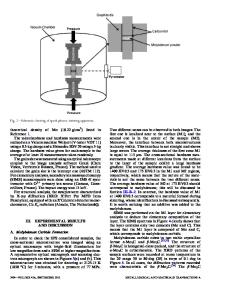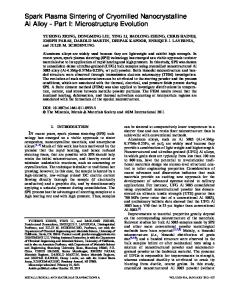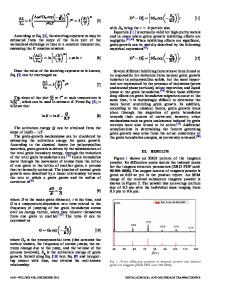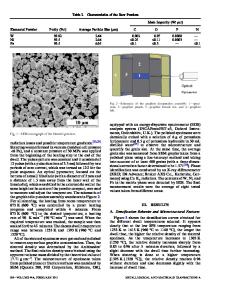Spark plasma sintering and characterization of bulk nanostructured fully stabilized zirconia: Part I. Densification stud
- PDF / 1,571,959 Bytes
- 8 Pages / 612 x 792 pts (letter) Page_size
- 65 Downloads / 310 Views
A. Tacca, F. Maglia, and G. Spinolo Department of Physical Chemistry, University of Pavia, 27100 Pavia, Italy (Received 20 February 2004; accepted 29 July 2004)
The sintering of nanosize powders of fully stabilized zirconia was investigated using the spark plasma sintering (SPS) method. The influence of sintering temperature, heating rate, direct current pulse pattern, sintering time, and sintering pressure on the final density and grain size of the product was investigated. The dependence of densification on temperature showed a maximum at 1200 °C, resulting with nearly fully dense zirconia with a crystallite size of about 100 nm. Heating rate (50∼300 °C min−1) and sintering time (5–16 min) had no significant influence on the final density and the crystallite size. Pulsing patterns ranging from 2:2 to 48:2 (on:off) had no influence on the density or the crystallite size. However, the applied pressure had a significant influence on the final density but no apparent effect on crystallite size for a sintering temperature of 1200 °C and a hold time of 5 min.
I. INTRODUCTION
In nanostructured materials, a significant fraction of atoms of a given crystallite resides on the surface or in the grain boundary region. Such an arrangement is expected to give rise to different behavior and properties, an expectation that has been verified in numerous studies.1–6 The observed increase in strength of nanocrystalline metals and the increase in ductility of nanocrystalline ceramics have led to suggestions that the mechanical behavior of these two classes of materials converge at the nanoscale.7 This would further lead to the prospect of enhanced forming of conventionally brittle materials. The preparation of porosity-free materials is therefore an important first step before such a goal can be achieved.7 The densification of nanometric ceramic powders, however, is a challenging process,4 as under conventional consolidation conditions grain growth (Ostwald ripening) can take place.8 The sintering of zirconia, including nanometric powders, with varying amounts of yttria or other oxide additives has been investigated using conventional sintering, microwave sintering, sinter forging, and tape sintering techniques.9–21 The majority of the work by far deals with the sintering of the partially stabilized phase, and
a)
Address all correspondence to this author. e-mail: [email protected] DOI: 10.1557/JMR.2004.0423 J. Mater. Res., Vol. 19, No. 11, Nov 2004
http://journals.cambridge.org
Downloaded: 10 Jul 2014
the results show success in obtaining dense, nanostructured bodies. However, the sintering of the fully stabilized cubic phase has received much less attention with only four recent attempts to consolidate it by pressureless sintering,9 microwave sintering,22 or by the spark plasma sintering (SPS) method.23,24 In all of these investigations, sintering was accompanied by large grain growth. In the microwave sintering, for example, high-density (97.2%) zirconia was obtained during sintering, but the grain size grew from about 1
Data Loading...











